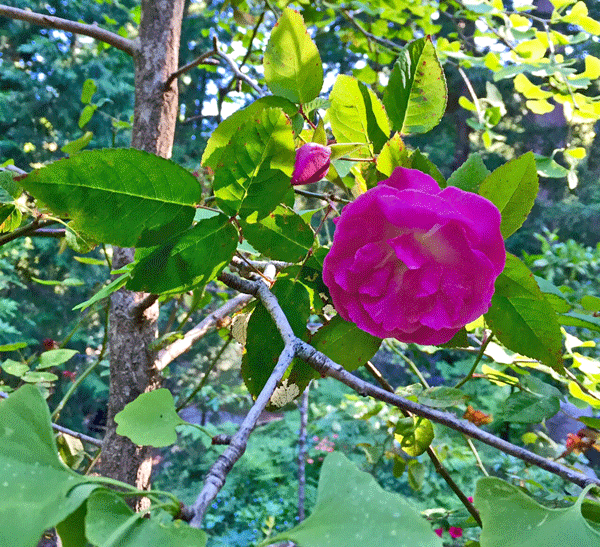My office window looks out on a gingko tree. Hanging from its low branches, two bird feeders are visited throughout the day by many songbirds.
As an added bonus, a climbing Zepherine drouhin rose grows up into the branches and has just started to bloom with vivid, dark pink flowers. They look like ornaments hanging from the tree. This spot wouldn’t be right for a trellis, so if it weren’t for the help of the gingko I wouldn’t be able to enjoy my beautiful rose. In your own garden think about trees, shrubs and even sturdy vines as support for other vines.
Creating an outdoor room with vines can make your yard feel cozy. They readily provide the walls to enclose a space. Views from one part of the garden may be partially open, framed by vines or blocked entirely.
Shrubs can also be used to create garden rooms since vines form a thin living wall that is quickly established. Creating boundaries with vines also adds vertical design elements to an otherwise flat landscape. By adding walls and a ceiling to your garden, you’ll be able to enjoy another dimension in addition to more color and fragrance too.
I’m always amazed at the variety of vines my friend Richard grows up into the canopy of his many trees. From Lady Banks rose to clematis to blood-red trumpet vine, to a spectacular double white pandora vine, his trees do double duty in his garden.
For a vine with long lasting interest, try growing an orange trumpet creeper up into a tree. It blooms from midsummer to early autumn and hummingbirds love it. It can tolerate wet or dry conditions, sun or shade, and is generally pest free.
Plant vines for fragrance in your garden. Let them scramble up a tree or through the branches of a shrub. Evergreen clematis bloom with showy white fragrant flower clusters above shiny dark green leaves in spring. Clematis montana is covered with vanilla scented pink flowers in spring as well. Carolina jessamine’s fragrant yellow flower clusters appear in masses from late winter into spring.
Another way to double your pleasure with vines is to let the thick stems of a mature, vigorous vine such as grape, wisteria, passionflower or a large climbing rose like Lady Banks, serve as a framework for a more delicate stemmed vine like clematis or Goldflame honeysuckle.
Or you can enjoy the classic combination of a flowering clematis like purple Jackmanii, intertwined with a white Iceberg rambling rose for another great look.
Other vines that are beautiful and easy to grow are our native honeysuckle, lonicera hispidula, with its translucent red berries in the fall. Violet trumpet vine, white potato vine, hardenbergia and Chilean jasmine are also good choices.
Growing vines is easy if you follow a few guidelines. To encourage bush growth on young vines, pinch out the stems’ terminal buds. If you want just a few vertical stems, though, don’t pinch the ends but instead remove all but one or two long stems at the base.
Often when I’m called out to take a look at a vine that has gotten out of control, the only advice I can give is to cut the entire vine to the ground in late winter or early spring and start training it all over again.
You can avoid this drastic measure by pruning periodically to keep your vine in bounds. Just before new growth begins, cut out unwanted or dead growth. If you can’t tell what to remove, cut the vine’s length by half and remove the dead stems later. On vines like hardenbergia or Carolina jessamine that bloom in late winter, wait to prune until after they have finished flowering.
Many vines require only deep but infrequent waterings. If you are interested in planting a new vine to provide color and fragrance in your garden, there are lots of good suggestions on the Scotts Valley Water Districts’ website at www.svwd.org.
Some to consider from their list of 800 low water-use plants are bougainvillea, trumpet creeper, Carolina jessamine, primrose jasmine, cat’s claw yellow trumpet vine, and purple leaf grape. Also on the website is a search function in the Water-Smart Gardening section for vines and other plants for particular situations such as shade, erosion, natives or low maintenance. It’s a valuable resource right at your fingertips.
– Jan Nelson, a landscape designer and California certified nursery professional, will answer questions about gardening in the Santa Cruz Mountains. E-mail her at ja******@*ol.com, or visit www.jannelsonlandscapedesign.com to view past columns and pictures.













